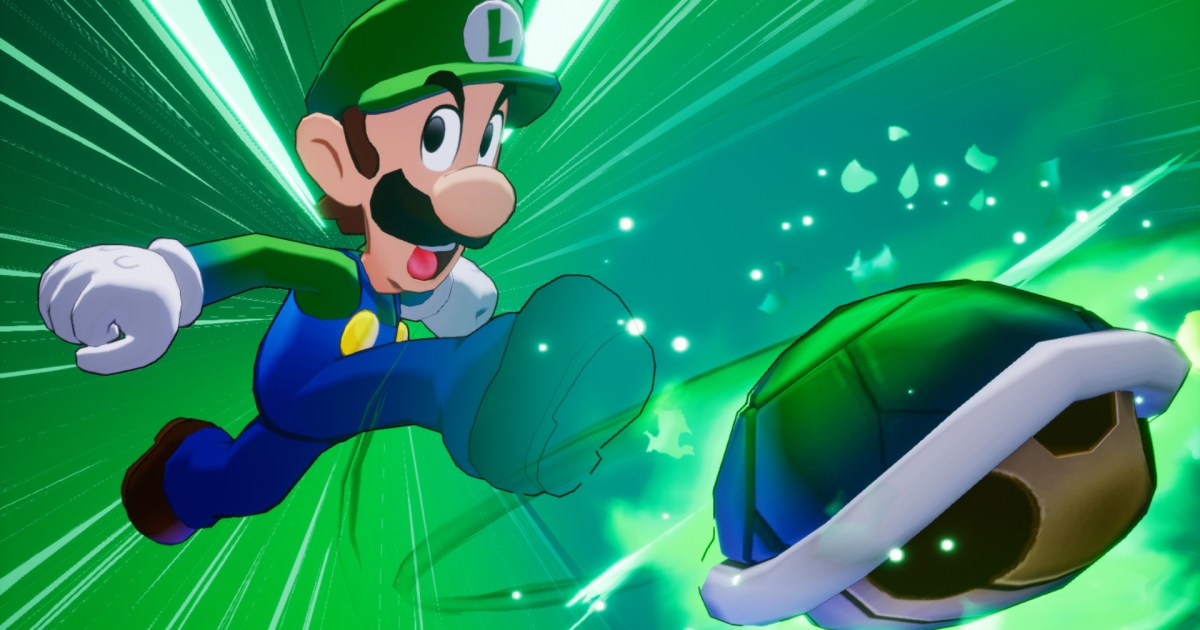Mario & Luigi: Brothership
MSRP $60.00
“Mario & Luigi: Brothership takes the Mario RPG series further away from the witty writing that made it special.”
Pros
- Expressive animation
- Sailing is a creative treat
- Innovative Battle Plugs
- Socially relevant story
Cons
- Sluggish pacing
- Poor performance
- Writing is devoid of wit
- Overloaded with gimmicks
Earlier this year, I revisited Paper Mario: The Thousand-Year Door for the first time in two decades. I remembered loving it as a kid, but it had been long enough that I couldn’t exactly tell you why it stuck with me at the time more than any Mario RPG since. It all came flooding back as soon as I played Nintendo’s excellent remake. I fell in love with its elegant battle system once again, laughed at all the same jokes that cracked me up in high school, and even found greater emotional depth in companions like Vivian that I hadn’t clocked at the time. Any hunch I had that maybe it was just something I liked as a kid was dispelled; it maintains the loyal fan base it still enjoys today for a reason.
Those highs make the lows of Mario & Luigi: Brothership feel that much lower. The first original entry in the RPG series in nine years — and the first without its creator, AlphaDream — looks a lot like the series (and spinoffs it was born from) on paper. It’s a colorful journey filled with button-timing combat, eccentric characters, and a grand narrative grounded in relevant social commentary. Then why didthe adventure hardly get a giggle out of me as I trudged through repetitive battles and endured endless minigames? Were games that I love like Bowser’s Inside Story always like this, or had I just grown out of them? Judging by my renewed love of The Thousand-Year Door, I don’t believe that’s the case.
Only two Italians have changed here, and I’m not one of them.
Mario & Luigi: Brothership puts some creative new spins on an old formula to make for the duo’s biggest RPG to date. Though for all its inventive combat tweaks, Brothership finds the series getting even further away from the strengths that set the Mario & Luigi series apart from everything else in the Mushroom Kingdom. Even with some bright spots, it can’t escape a continued downslide for a series that can’t help but trade in clever writing for dull gimmicks.
Ambition at its technical limits
Mario & Luigi: Brothership doesn’t change the series’ once-winning formula too much, but it does expand it significantly. This time around, the brothers find themselves whisked away to the kingdom of Concordia, a once-united land that’s been split up into several islands. It’s up to Mario and Luigi to reunite the plug-headed inhabitants of the land by traveling from island to island via a living ship and physically reconnecting them all. That premise opens the door for a structurally sound game that feels custom-built for Nintendo’s hybrid mobile/home system, just like some of the Switch’s best.
The 45-hour adventure is built to be eaten in bite-sized chunks. Early on, each island contains its own little story that takes about an hour or two to get through. On one, Mario and Luigi have to help a depressed dancer fix their fallen hair. Another throws the pair in the middle of a Romeo and Juliet-style love story on an island of hot and cold people who hate one another. Those micro tales are occasionally charming, but tend to give the story a bit of a start-and-stop feel as the wider narrative congeals much later. One island simply has me playing hide-and-seek with a gang of rascals, a fairly dull task that just feels like it’s filling time.

That’s a running theme in Brothership, which often crawls along at a sluggish pace despite changing the scenery so often. It takes a good eight hours for it to introduce its full battle system, at which point it first starts to gather momentum. Too much of its overstuffed runtime is clogged with tutorials, hollow exposition, frustrating minigames, and more pace-killing annoyances that have crept into the series more and more over the years. It’ll make you appreciate just how streamlined the 15-hour Super Mario RPG is; it’s an adventure that feels just as grand and eccentric with way less fat on the bone.
There are some inspired moments that stand out in the flood of ideas. One formula shake-up sees Mario & Luigi traveling around on Shipshape Island, a moving hub world that they can navigate along a map of currents to find new islands, collectible reefs, and islets (with punny names about their size) featuring optional challenges. The traversal hook lets players chart a course to a far-off current, but then warp to a previously discovered island to check off any sidequests as the ship is in motion. That system is quickly trivialized by a quick sailing option that gets the ship to its location in a snap, but it’s a smart way to keep players waiting around while the ship moves.
The Nintendo Switch can’t quite keep up with it all.
The most visible change — quite literally — is Brothership’s striking art style. The colorful makeover turns Mario into a full-on cartoon, continuing the recent Disneyfication of the series with some mixed results. When it’s in motion, the expressive animations can feel like a revelation. Special Bro.s Attacks, like one where the brothers freeze time and whack their foes with a flurry of over-the-top hammer smashes, are full of personality. Of all things, it feels like a continuation of Mario Strikers: Battle League, a sports spinoff that excelled at selling the ‘toon strength of its footballers.
That style doesn’t work as well in more static moments, as splotchy textures and jagged lines can make it look far older than it is at a glance. What’s even more troubling is that the Nintendo Switch can’t quite keep up with it all. Performance takes a major hit in its flashiest moment,s with the frame rate tanking during climactic battles. The worst of it happens on Shipshape Island, which is an evolving hub that fills up with NPCs as more islands are connected to the ship. The slowdown crept in more and more with each new island, as my Switch OLED was pushed to its limits in handheld mode. There’s a lot of ambition here, and I’m left wondering if it would have been better served by waiting for Nintendo’s next hardware bump.
Innovative battles
While there are moments of fun platforming between clunky button-timing minigames, Brothership is at its best when it’s focused on its RPG elements. The core combat hasn’t changed too much from previous Mario & Luigi games; each brother can attack with their boots or hammer, but players need to hit some buttons at the right moment to maximize their damage or dodge and counter incoming attacks. It’s as satisfying as ever, but that basic loop gets old quickly as the easily executable attack timings virtually never change no matter what gear is equipped. You’ll almost always see the same animation of Luigi launching his brother into the air when jumping on an enemy.
This has been true in a lot of previous games, but it especially feels like a missed opportunity for one whose bread-and-butter is its expressive animations. Even the short suite of Bros. Attacks is a bit head-scratching seeing as the game’s most visually exciting moments become dull when watching them play out the same way dozens of times. Battles can feel drawn out as a result; the animations meant to make them feel more dynamic wind up ballooning each one’s length instead. By the end, I found myself fleeing more often than I wanted to.
It’s encouraging to see a Mario RPG that’s so confident about its battle system.
Thankfully, there’s an innovative twist here that makes battles much more engaging, at least for a while: Battle Plugs. As a free action during turn-based battles, players can set plugs that grant the brothers passive effects. Some are defensive, making counters easier to pull off or more powerful. Others are more of a utility; I can set plugs that make my healing items more effective. That turns even the most basic action into a strategic puzzle. Say that I anticipate a brother might drop dead on the next turn if I beef a dodge. I could set an auto 1-up plug to bring them back without wasting a turn, but also set another plug that “boomerangs” my mushroom back to my inventory once it’s used. Plugs short out after a bit and need to recharge after a certain amount of turns, so I need to always have multiple strategies I can fall back on when one key plug goes down.
Finding effective combinations becomes the most exciting part of Brothership, as they make those repetitive basic attacks at least feel more devastating over time. Battles become a meta game where I’m pushing myself to see how much damage I can dish out in one turn. That pairs well with Brothership’s deeper RPG systems, which give me more agency over what permanent passive perks each brother gets and let me play with a wide assortment of gear with specific abilities. In my playthrough, I built Mario’s stats around his Bros. Attacks. Not only would he get bonus damage for executing them and spend less Bros. Points (BP) when doing so, but I’d set plugs that would boost their damage further at the expense of spending more BP, another that would cut that BP cost back down if I performed it perfectly, and another still that automatically carried out the attack perfectly. By the end, attacks that did a couple hundred points of damage were doing 2,000.

While satisfying, the system has its limits. Despite having a good chunk of plugs by the end of the adventure, I sometimes felt that there were only a handful of obvious synergies to discover. There’s a bit of clever experimentation to be done with a set of plugs that affect how others recharge, but I found myself still using the first ones I crafted regularly through to the end of the game. Plugs also tend to make already long battles even longer, as I need to scroll through a list and set a handful of plugs on each turn. I yearn for an option to create plug sets that I can swap in with a quick shortcut.
Even with those issues, Battle Plugs are the one area where it feels like the Mario & Luigi series is moving in the right direction. It almost feels like Nintendo has tried to downplay Mario’s deeper RPG systems over the past decade, with games like Paper Mario: The Origami King feeling more like puzzle platformers with light progression hooks. It’s encouraging to see a Mario RPG that’s so confident about its battle system and eager to innovate it, even if Brothership can feel like a good first draft at times.
A series divided
While the RPG hooks are well handled, Brothership’s writing is a low point – and that’s the last thing you want to hear about a Mario RPG. From the plumber’s first foray into turn-based adventures, games like Paper Mario have been a great platform for Nintendo to flex its comedic chops and narrative muscles. The Thousand-Year Door is a certified stand-up routine featuring some of Nintendo’s most lovable misfits. Even The Origami King, for all its faults, still contains a story about a Bob-omb companion that might move you to tears.
Brothership has the bones of a great story. In it, Mario and Luigi fight to unite the citizens of Concordia and save its residents from a disease that’s transforming them into lonely grumps. Oddly enough, it’s the most socially relevant a Mario game has ever felt. It’s the story of a social division and how technology (represented as the dastardly Extension Corps) can turn us into angry, isolated curmudgeons who are always complaining. Its finale builds to a genuinely emotional payoff, even if it’s amid a left-field tonal shift that I wished had been there the entire adventure instead of stuffed into a long-winded ending stretch.
Brothership can’t help but stack gimmicks on top of one another.
You’ll have to wade through a lot of dead air to get to that, though. Brothership is virtually devoid of wit even compared to the series’ unfunniest games. There’s some fun visual slapstick to be found in traversal abilities that transform the brothers into a UFO, but the flat writing barely got a giggle out of me over 45 hours. The inhabitants of Concordia often feel devoid of personality, and seem be there just to point me in the right direction rather than add color to the world. Maybe that’s the point; perhaps isolation has made everyone I meet a total drag to be around. But more probably, it’s the side effect of the series passing over to a new developer that doesn’t quite have the comedic chops of AlphaDream just yet.
What’s more notable is just how creatively disorganized the hodgepodge adventure feels. The kingdom of Concordia revolves around a giant tree that unites the world, but the story focuses on plugging in electrical sockets. It’s a nautical adventure about sailing the ocean on top of that. There’s a fire and ice motif dropped in halfway through that becomes the focus for a while. Fan-favorite characters pop in and out of the story with little rhyme or reason. There is no cohesion to Brothership’s story, which feels like it’s being told by an imaginative 7 year old who can’t stay focused.
That bleeds into the gameplay too, as Brothership can’t help but stack gimmicks on top of one another. While sailing and Battle Plugs feel like the focus, there’s also a glut of minigames and platforming obstacles that get more frustrating as the adventure drags on. There’s also Luigi Logic, in which Luigi occasionally dreams up a deus ex machina to get the brothers out of a bind. It’s a holdover from Mario & Luigi: Dream Team, but that game was specifically about dream logic. It made sense for Luigi to roll into a giant ball in the context of that surreal story; here, it just feels random.

Brothership’s problems will look familiar to anyone who found themselves disappointed by games like Mario & Luigi: Paper Jam or Paper Mario: Sticker Star. Nintendo has seemingly convinced itself that every Mario RPG needs to have bespoke gimmicks. It’s not enough to give players a well-written story and iterate on a solid combat foundation; there always has to be a twist, or two, or three. Those layers drag Brothership down the longer the adventure goes on, making even its intriguing climax feel exhausting by the end.
I wouldn’t label Mario & Luigi: Broithership as a bad game, but what’s cruelly ironic is that it’s a middle of the road effort that’s sure to sow the very division its story aims to combat. Some fans will love it, praising its cheery visuals and deep combat system. Others will hate it, feeling like it’s another part of a long series downslide. The overly simplistic score I’ve put on this review will inevitably end up in a social media thread aggregating reviews, and the comments will be filled with people personally insulting me or this publication before playing the game themselves or even reading this critique. Rather than talking to one another and trading our perspectives in good faith, bitter arguments will flare up across technology that once united us, but now incentivizes people to become the most bitter, isolated versions of themselves.
Mario & Luigi: Brothership has a vital lesson to teach us about staying connected to one another and welcoming our differences. I just fear that neither it’s overly enthusiastic defenders or most jaded haters will get the message when there’s so much other stuff in the way.
Mario & Luigi: Brothership was tested on a Nintendo Switch OLED.
Read the full article here














